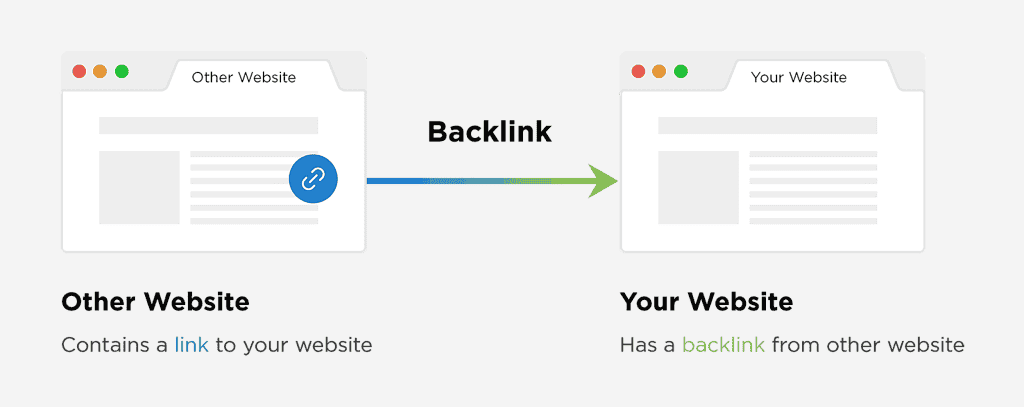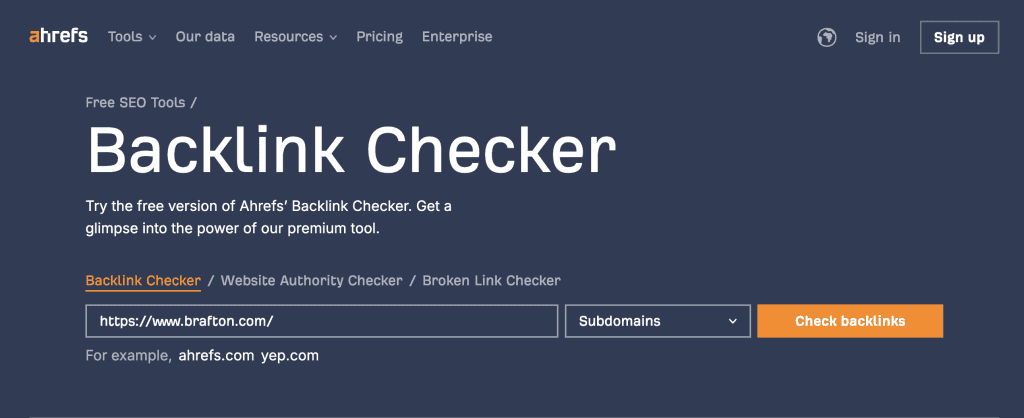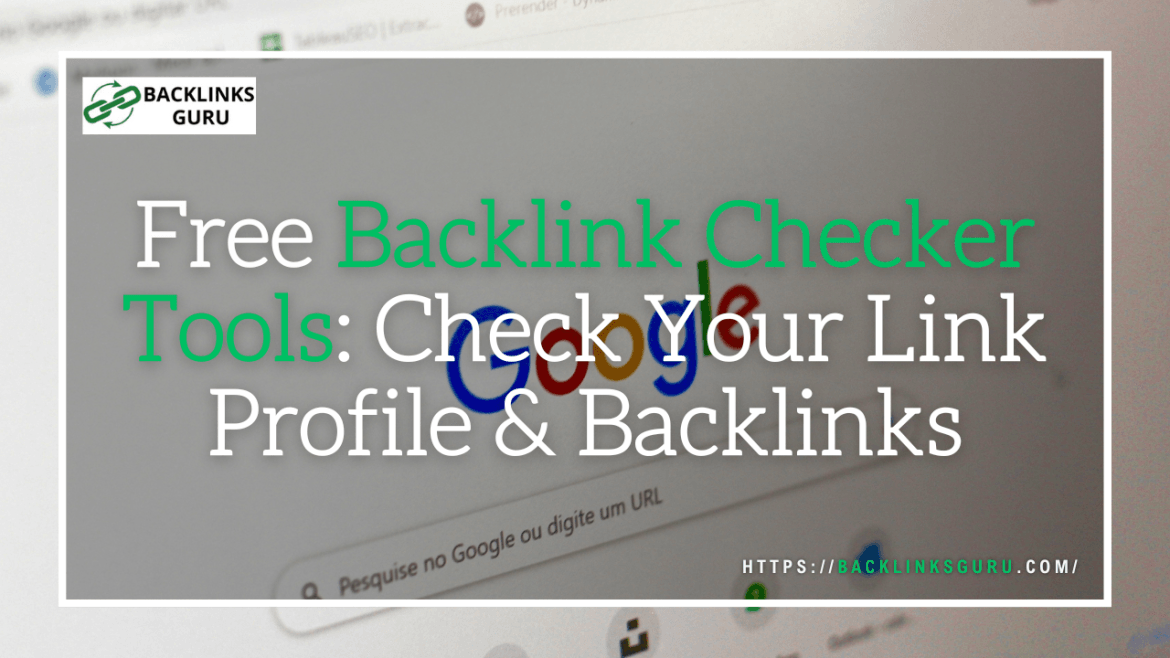🔗 Check Your Backlinks — Use Free Backlink Checker Tools to Analyze & Improve Your SEO Profile Effortlessly 🚀
In the vast landscape of search engine optimization (SEO), understanding and managing your link profile is crucial for achieving higher rankings. A key component of this is analyzing backlinks, the inbound links from other websites to your own. Fortunately, many free backlink checker tools are available to help you monitor these vital connections. To help you understand their characteristics, consider the following summary:
| Concept | Description |
|---|---|
| Backlinks | Inbound links from other websites to your own. |
| Free Backlink Checker Tools | Tools used to monitor backlinks. |
This article will guide you through understanding backlinks and their importance for SEO, and how to use these free tools to improve your website’s performance.

Understanding Backlinks
What are Backlinks?
Backlinks, also known as inbound links, are links from one website to another. In the context of SEO, backlinks act as a vote of confidence from one site to another. When a website links to yours, it is essentially vouching for the quality and relevance of your content. Search engines like Google view backlinks as a critical ranking factor, indicating that your website is a valuable and trustworthy resource. The more valuable links you have, the higher your ranking.
The Importance of Backlinks for SEO
Backlinks are a cornerstone of any successful SEO strategy because search engines use them to determine the authority and relevance of a website. A strong link profile, characterized by a high number of backlinks from reputable referring domains, can significantly boost your website’s ranking in search engine results pages (SERPs). This increased visibility can lead to more organic traffic, which translates to more customers or readers and improve your backlink profile.
Types of Backlinks
Not all backlinks are created equal. Different types of backlinks vary in their impact on your SEO. For example, follow links pass link equity, directly contributing to your website’s ranking potential. Nofollow links, on the other hand, do not pass link equity but can still drive referral traffic and increase brand awareness. Additionally, the anchor text used in a backlink can influence how search engines perceive the linked page’s relevance to specific keywords.
Here’s a helpful breakdown of the main types of backlinks used in SEO, explained simply:
1. Dofollow Backlinks
These are the most valuable type of backlinks. A dofollow link tells search engines to pass on link equity (SEO value) from the referring site to the destination. These help improve search engine rankings and are typically earned through high-quality content, guest posts, or natural mentions.
2. Nofollow Backlinks
A nofollow backlink tells search engines not to pass on link equity. These are often used in blog comments, press releases, social media, and sponsored content. While they don’t directly impact rankings, they still help with traffic, brand exposure, and diversification of your backlink profile.
3. Sponsored Backlinks
These links are paid placements and should include the attribute rel="sponsored". They are used for advertising and must be disclosed to comply with Google’s guidelines. Ignoring this can lead to SEO penalties.
4. UGC (User-Generated Content) Backlinks
These backlinks come from content created by users, like forum posts or blog comments. To remain compliant with Google’s best practices, these links should include the rel="ugc" tag. They may not pass link juice, but they can bring referral traffic.
5. Contextual Backlinks
These links are placed within the body of relevant content (like blog articles). Contextual backlinks are some of the most powerful in SEO because they appear natural and often come from editorial mentions.
6. Image Backlinks
When someone links to your website using an image (like an infographic), that’s an image backlink. These can be powerful when the image is hosted on another high-authority domain with proper alt text and source URL.
7. Guest Post Backlinks
Backlinks earned by writing guest posts on other blogs. This is a popular and effective white-hat SEO strategy when done with original content on relevant sites.
8. Profile Backlinks
Created by adding your website’s URL to profiles on forums, directories, or social platforms. While often low-authority, these help diversify your backlink profile.
9. Directory Backlinks
These come from online directories and listings. While many are outdated or spammy, reputable niche directories can still offer SEO value and referral traffic.
10. Social Media Backlinks
Although mostly nofollow, links from platforms like Facebook, Twitter, LinkedIn, Pinterest, and Instagram help increase visibility, brand authority, and drive traffic.

Free Backlink Checker Tools
Top Free Backlink Checker Tools
Numerous free backlink checker tools are available to help you check your backlinks and analyze your link profile. These free SEO resources provide valuable backlink data without requiring a subscription. Here’s a summary of some popular options:
- Ahrefs Free Backlink Checker
Provides a snapshot of a website’s backlink profile, including top backlinks, referring domains, and anchor text. - Semrush Backlink Analytics (Free Version)
Allows users to check backlinks and referring domains for any site with limited access on the free plan. - Neil Patel’s Ubersuggest
Offers insights on backlinks, domain authority, new and lost links, and anchor text data. - SE Ranking Backlink Checker
Includes backlink analysis, domain trust score, referring IPs, and link type distribution. - Majestic Backlink Analyzer
Features metrics like Trust Flow, Citation Flow, and backlink history data. - Seobility Backlink Checker
Offers a quick view of backlinks, linking pages, and the proportion of follow vs nofollow links. - Linkody Free Backlink Checker
Displays up to 100 top backlinks along with data on anchor text, domain authority, and status. - OpenLinkProfiler
Provides a wide range of backlink data including link type, industry relevance, and freshness. - SEO Review Tools
Delivers detailed backlink metrics including value-based sorting and anchor text analysis. - Backlink-Tool.org
A simple and easy-to-use tool that provides backlink data without the need for account registration.
Each free tool has its strengths, so experimenting to find the best fit for your needs is helpful.
How to Use a Free Backlink Checker Tool
Using a free backlink checker tool is generally straightforward. Simply enter your domain or a specific URL into the search bar and initiate the backlink checking process. The tool will then crawl the web and compile a report showing the backlinks pointing to that domain. The report will include a list of referring domains, anchor text used, and possibly some domain authority metrics. These results will help you check the backlinks of your website.
Features to Look for in Backlink Checker Tools
When selecting a free backlink checker tool, consider the features that are most important to you. Look for tools that provide a comprehensive backlink database, allow you to see a substantial number of backlinks, show referring domains, anchor text variations, and domain authority scores. The ability to analyze competitor backlinks and identify link building opportunities can also be extremely valuable.

Analyzing Your Backlink Profile
What is a Backlink Profile?
Your backlink profile is the collection of all inbound links pointing to your website from other websites. It provides a comprehensive overview of your website’s authority and influence within your industry. A strong link profile typically consists of a diverse range of high-quality backlinks from reputable referring domains. This diverse range signals to search engines that your content is trustworthy, useful, and relevant.
Key Metrics in Backlink Analysis
Here’s a helpful overview of key metrics in backlink analysis that SEO professionals commonly use to evaluate link quality and overall impact on search rankings:
1. Domain Authority (DA) / Domain Rating (DR)
These metrics (from Moz and Ahrefs respectively) estimate the overall authority and backlink strength of a domain. Higher values generally suggest a stronger ability to pass SEO value.
2. Page Authority (PA) / URL Rating (UR)
Similar to DA/DR, but focused on the strength of a specific page rather than the whole domain. Useful for evaluating the actual linking page.
3. Referring Domains
The number of unique domains linking to your site. A high number of diverse referring domains typically signals a strong backlink profile.
4. Backlink Type (DoFollow vs. NoFollow)
DoFollow links pass link equity (ranking power), while NoFollow links don’t—although they can still drive traffic and brand visibility.
5. Anchor Text Distribution
Anchor text helps search engines understand what the linked content is about. Monitoring for over-optimization or spammy anchor text is crucial.
6. Link Relevance
A link from a relevant, topic-specific site is more valuable than one from an unrelated site, even if the unrelated one has a higher authority.
7. Link Placement
Links placed within the main content of a page (editorial links) tend to carry more weight than those in footers, sidebars, or comment sections.
8. Link Freshness
Search engines favor recently earned links, and regularly updated link profiles can help maintain or improve rankings.
9. Spam Score / Toxicity Score
Some tools rate how spammy or potentially harmful a backlink is. Avoid backlinks from high-risk domains that could hurt your SEO.
10. Traffic of Linking Domain
Backlinks from domains that receive actual organic traffic are more valuable than links from dead or low-traffic sites.
How to Check Your Backlinks
To check your backlinks, you can utilize one of the many free backlink checker tools available for free. Enter your domain into the tool to generate a report of backlinks pointing to your site. Pay close attention to the referring domains, anchor text, and domain authority of each backlink. Regularly check the backlinks to identify new links and any potentially harmful or low-quality backlinks that may need to be disavowed.
Improving Your Backlink Profile
Link Building Strategies
Effective link building strategies are essential for improving your backlink profile. These strategies often include creating high-quality, shareable content that naturally attracts backlinks. Guest blogging on reputable referring domains within your industry can also be a valuable link source. Furthermore, broken link building involves finding broken links on other sites and offering your relevant content as a replacement, thus creating new links.
Common Mistakes to Avoid
Several common mistakes can harm your backlink profile. Avoid participating in link schemes or purchasing backlinks, as these practices violate search engine guidelines and can result in penalties. Overusing exact match anchor text can also appear unnatural to search engines. Regularly check your backlinks and disavow any low-quality or spammy referring domains to maintain a healthy link profile.
Using Backlink Reports for Strategy
Backlink reports generated by a free backlink checker provide actionable insights that can inform your SEO strategy. By analyzing the referring domains, anchor text, and domain authority of your backlinks, you can identify strengths and weaknesses in your link profile. Use this backlink data to focus your link building efforts on acquiring backlinks from high-authority sites with relevant anchor text.

Competitive Analysis of Backlinks
How to Check the Backlinks of Any Website
Understanding how to check the backlinks of any website is vital for competitor backlinks analysis. Use a free backlink checker tool and enter the URL of a competitor’s domain to reveal their backlink profile. Analyze the referring domains, anchor text distribution, and domain authority of their backlinks to identify link opportunities and potential link building targets for your own SEO campaign.
Understanding Referring Domains and Anchor Text
Analyzing referring domains and anchor text is crucial in backlink analysis. The quality and relevance of referring domains significantly impact the value of backlinks. Diversifying your anchor text helps avoid over-optimization, making your link profile appear more natural. By understanding these elements, you can strategically target high-authority referring domains and optimize anchor text for better rankings.
Leveraging Backlink Data for Competitive Advantage
Leveraging backlink data provides a significant competitive advantage. By using a free backlink checker tool to examine competitor backlinks, businesses can uncover link opportunities that drive SEO. Identifying valuable link sources and replicating successful link building strategies will boost website authority and ranking. Regular backlink analysis helps businesses stay ahead in the competitive landscape and improve search engine visibility.

Frequently Asked Questions
What is a free backlink checker tool?
A free backlink checker tool is an SEO tool that allows users to analyze the backlink profile of their website or any other URL. It provides insights into the total number of backlinks, referring domains, and the quality of those backlinks, helping users understand their link building efforts and opportunities.
How can I check my backlinks using a free tool?
You can check your backlinks by using a free backlink checker. Simply enter your website’s URL into the tool, and it will generate a report detailing the backlinks to your site, including metrics such as the number of referring domains and the quality of those links.
Why do backlinks matter for SEO?
Backlinks matter for SEO because they are a key factor in determining your site’s authority and ranking in search engine results. A strong backlink profile with valuable backlinks from reputable sources can enhance your website’s visibility and drive more organic traffic.
What are the benefits of using a backlink analysis tool?
Using a backlink analysis tool allows you to gain insights into your website’s backlinks, identify lost backlinks, analyze competitor backlinks, and discover new link building opportunities. This information is crucial for improving your off-page SEO and crafting effective link building strategies.
How do I find new link building opportunities?
You can find new link building opportunities by using a backlink checker tool to analyze your competitors’ backlink profiles. By examining the backlinks of your competitors, you can identify sites that link to them and reach out for potential partnerships to acquire backlinks for free.
What are broken backlinks and why should I check for them?
Broken backlinks are links that lead to non-existent pages or 404 errors. Checking for broken backlinks is essential because they can negatively impact your site’s SEO. By identifying and fixing these links, you can improve your backlink profile and enhance user experience.
Can I see backlinks of any website using a free backlink checker?
Yes, most free backlink checker tools allow you to see backlinks of any website. By entering the desired URL, you can analyze its backlink data, including the number of external backlinks and referring domains, which provides valuable insights into their link building efforts.
What should I include in a backlink report?
A comprehensive backlink report should include metrics such as the total number of backlinks, the number of referring domains, the quality of backlinks, anchor text used, and any lost backlinks. This data will help you assess your backlink profile and develop strategies for improvement.



